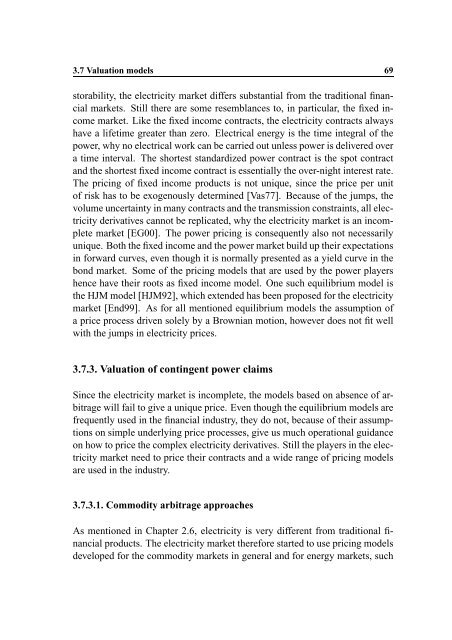Hedging Strategy and Electricity Contract Engineering - IFOR
Hedging Strategy and Electricity Contract Engineering - IFOR
Hedging Strategy and Electricity Contract Engineering - IFOR
Create successful ePaper yourself
Turn your PDF publications into a flip-book with our unique Google optimized e-Paper software.
3.7 Valuation models 69<br />
storability, the electricity market differs substantial from the traditional financial<br />
markets. Still there are some resemblances to, in particular, the fixed income<br />
market. Like the fixed income contracts, the electricity contracts always<br />
have a lifetime greater than zero. Electrical energy is the time integral of the<br />
power, why no electrical work can be carried out unless power is delivered over<br />
a time interval. The shortest st<strong>and</strong>ardized power contract is the spot contract<br />
<strong>and</strong> the shortest fixed income contract is essentially the over-night interest rate.<br />
The pricing of fixed income products is not unique, since the price per unit<br />
of risk has to be exogenously determined [Vas77]. Because of the jumps, the<br />
volume uncertainty in many contracts <strong>and</strong> the transmission constraints, all electricity<br />
derivatives cannot be replicated, why the electricity market is an incomplete<br />
market [EG00]. The power pricing is consequently also not necessarily<br />
unique. Both the fixed income <strong>and</strong> the power market build up their expectations<br />
in forward curves, even though it is normally presented as a yield curve in the<br />
bond market. Some of the pricing models that are used by the power players<br />
hence have their roots as fixed income model. One such equilibrium model is<br />
the HJM model [HJM92], which extended has been proposed for the electricity<br />
market [End99]. As for all mentioned equilibrium models the assumption of<br />
a price process driven solely by a Brownian motion, however does not fit well<br />
with the jumps in electricity prices.<br />
3.7.3. Valuation of contingent power claims<br />
Since the electricity market is incomplete, the models based on absence of arbitrage<br />
will fail to give a unique price. Even though the equilibrium models are<br />
frequently used in the financial industry, they do not, because of their assumptions<br />
on simple underlying price processes, give us much operational guidance<br />
on how to price the complex electricity derivatives. Still the players in the electricity<br />
market need to price their contracts <strong>and</strong> a wide range of pricing models<br />
are used in the industry.<br />
3.7.3.1. Commodity arbitrage approaches<br />
As mentioned in Chapter 2.6, electricity is very different from traditional financial<br />
products. The electricity market therefore started to use pricing models<br />
developed for the commodity markets in general <strong>and</strong> for energy markets, such
















